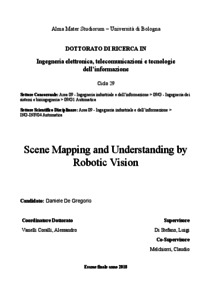Documenti full-text disponibili:
![[img]](http://amsdottorato.unibo.it/8585/1.hassmallThumbnailVersion/2017-03-14.PhD.Thesis.DanieleDeGregorio_CORRETTA.pdf)  Anteprima |
|
Documento PDF (English)
- Richiede un lettore di PDF come Xpdf o Adobe Acrobat Reader
Disponibile con Licenza: Salvo eventuali più ampie autorizzazioni dell'autore, la tesi può essere liberamente consultata e può essere effettuato il salvataggio e la stampa di una copia per fini strettamente personali di studio, di ricerca e di insegnamento, con espresso divieto di qualunque utilizzo direttamente o indirettamente commerciale. Ogni altro diritto sul materiale è riservato.
Download (28MB)
| Anteprima
|
Abstract
The first mechanical Automaton concept was found in a Chinese
text written in the 3rd century BC, while Computer Vision was born
in the late 1960s. Therefore, visual perception applied to machines (i.e. the Machine Vision) is a young and exciting alliance.
When robots came in, the new field of Robotic Vision was born, and these terms began to be erroneously interchanged. In short, we can say that Machine Vision is an engineering domain, which concern the industrial use of Vision. The Robotic Vision, instead, is a research field that tries to incorporate robotics aspects in computer vision algorithms. Visual Servoing, for example, is one of the problems that cannot be solved by computer vision only. Accordingly, a large part of this work deals with boosting popular Computer Vision techniques by exploiting robotics: e.g. the use of kinematics to localize a vision sensor, mounted as the robot end-effector. The remainder of this work is dedicated to the counterparty, i.e. the use of computer vision to solve real robotic problems like grasping objects or navigate avoiding obstacles. Will be presented a brief survey about mapping data structures most widely used in robotics along with SkiMap, a novel sparse data structure created both for robotic mapping and as a general purpose 3D spatial index. Thus, several approaches to implement Object Detection and Manipulation, by exploiting the aforementioned mapping strategies, will be proposed, along with a completely new Machine Teaching facility in order to simply the training procedure of modern Deep Learning networks.
Abstract
The first mechanical Automaton concept was found in a Chinese
text written in the 3rd century BC, while Computer Vision was born
in the late 1960s. Therefore, visual perception applied to machines (i.e. the Machine Vision) is a young and exciting alliance.
When robots came in, the new field of Robotic Vision was born, and these terms began to be erroneously interchanged. In short, we can say that Machine Vision is an engineering domain, which concern the industrial use of Vision. The Robotic Vision, instead, is a research field that tries to incorporate robotics aspects in computer vision algorithms. Visual Servoing, for example, is one of the problems that cannot be solved by computer vision only. Accordingly, a large part of this work deals with boosting popular Computer Vision techniques by exploiting robotics: e.g. the use of kinematics to localize a vision sensor, mounted as the robot end-effector. The remainder of this work is dedicated to the counterparty, i.e. the use of computer vision to solve real robotic problems like grasping objects or navigate avoiding obstacles. Will be presented a brief survey about mapping data structures most widely used in robotics along with SkiMap, a novel sparse data structure created both for robotic mapping and as a general purpose 3D spatial index. Thus, several approaches to implement Object Detection and Manipulation, by exploiting the aforementioned mapping strategies, will be proposed, along with a completely new Machine Teaching facility in order to simply the training procedure of modern Deep Learning networks.
Tipologia del documento
Tesi di dottorato
Autore
De Gregorio, Daniele
Supervisore
Co-supervisore
Dottorato di ricerca
Ciclo
29
Coordinatore
Settore disciplinare
Settore concorsuale
Parole chiave
Robotic Vision, Machine Learning
URN:NBN
DOI
10.48676/unibo/amsdottorato/8585
Data di discussione
8 Maggio 2018
URI
Altri metadati
Tipologia del documento
Tesi di dottorato
Autore
De Gregorio, Daniele
Supervisore
Co-supervisore
Dottorato di ricerca
Ciclo
29
Coordinatore
Settore disciplinare
Settore concorsuale
Parole chiave
Robotic Vision, Machine Learning
URN:NBN
DOI
10.48676/unibo/amsdottorato/8585
Data di discussione
8 Maggio 2018
URI
Statistica sui download
Gestione del documento:


 Login
Login
